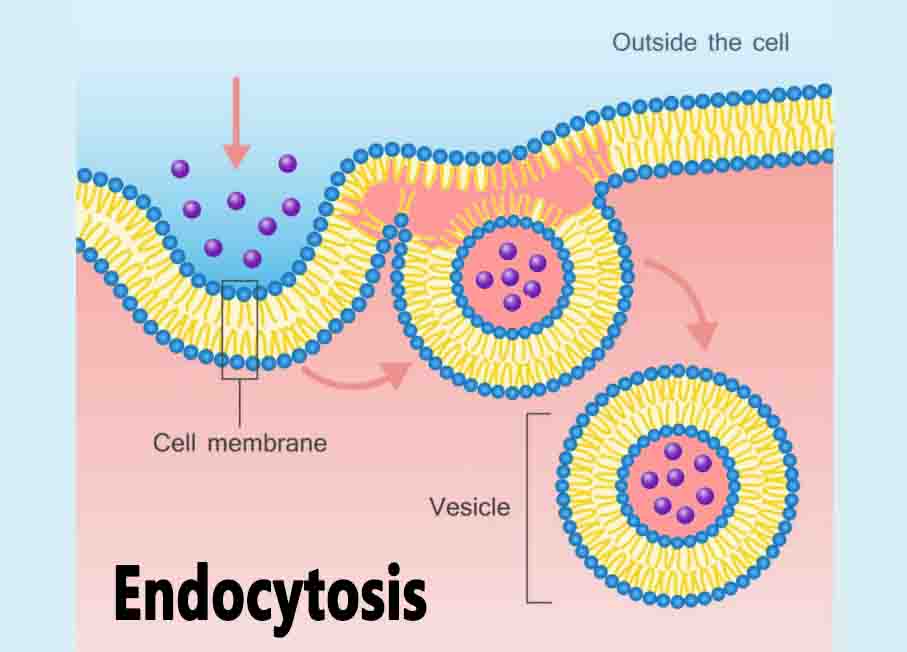Endocytosis Definition
Endocytosis is the process of actively transporting molecules into the cell by engulfing it with its membrane. Endocytosis and exocytosis are used by all cells to transport molecules that cannot pass through the membrane passively. Exocytosis provides the opposite function and pushes molecules out of the cell.
Like all systems in the human body, the need for homeostasis enables an equal flow of molecules in and out of the cell. This means the amount of molecules entering the cell by endocytosis is equal to the amount of molecules exiting the cell via exocytosis. The two processes combined ensure there is a balance of nutrients and waste for regular cell life and function.
Necessary components in the endocytic pathway are early endosomes, late endosomes, and lysosomes. Early endosomes are responsible for receiving vesicles on the cell surface. They sort the received molecules into the other components in the pathway through trans vesicular compartments such as endosomal carrier vesicles or multivesicular bodies. Late endosomes then receive the molecules from early endosomes.
They begin the degradation of the molecules and can also receive molecules from the trans-Golgi network or from phagosomes. Late endosomes then deliver the molecules to lysosomes. Lysosomes contain enzymes that break down carbohydrates, proteins, fats, and other cellular waste products into smaller, simpler components. These components are then delivered back to the cytoplasm to be used as building materials throughout the cell.
Types of Endocytosis
There are four different types, or pathways, of endocytosis: caveolae, macropinocytosis, receptor-mediated endocytosis, and phagocytosis. Each pathway has a different way of bringing in encapsulated molecules. Caveolae are non-clathrin coated buds that are formed and located on the plasma membrane, and are composed of caveolin, an integral membrane protein.
The caveolin activate, shape, and maintain the formation of “caves” on the cell membrane, or caveolae. They serve as “collection” pits that gather specific molecules for cell signaling and metabolic pathways.
The next three endocytosis operations use the clathrin system; clathrins are proteins that gather on the inside of the cell membrane when endocytosis is initiated. Due to their structure, clathrins, when stimulated, naturally bond to one another to form cages around the ingested molecules.
Macropinocytosis is the process of ingesting larger molecules, and is activated when the cell membrane undergoes cell surface ruffling, or structural reformation of the membrane. The physical stimulation causes vesicles to form; these are later internalized. This has made macropinocytosis less selective and more efficient than the other types of endocytic processes.
Unlike macropinocytosis, receptor-mediated endocytosis relies on cell surface receptors to distinguish certain molecules and therefore can only bring in molecules in a one-to-one ratio. Molecules will accumulate on the cell surface and signal the membrane to begin ingestion. Once the concentration is high enough, invagination begins with the recruitment of clathrins forming a coat or cage around the particle.
Phagocytosis engulfs molecules by manipulating the cell’s membrane to surround and grab molecules, creating a vesicle called phagosomes. Phagocytosis is unique in that it specializes in the destruction and disposal of waste.
Function of Endocytosis
Endocytosis is used for receptor signaling, nutrient uptake, membrane remodeling, pathogen entry, and neurotransmission, as well as modulating cell signaling responses. In developing tissues, it has been found that endocytosis aids in cell migration.
Toxins, pathogens, and foreign debris have also been found to exploit the different endocytic pathways in order to gain entry into the cell. The particles will recruit clathrins (proteins necessary for vesicle shape and formation) or will initiate the first steps of the pathway in order to begin the process to enter the cell.
Example of Endocytosis
Cholesterol is a much needed component in the cell that is present in the plasma membrane and is also used as a hormone precursor. A lipoprotein complex (such as LDL or low density lipoprotein) is then used to transport the cholesterol to other cells in the body. On the surface of the cell is a LDL receptor that binds the LDL complex to begin the endocytic process.
These receptors were synthesized in the Endoplasmic Reticulum (ER) and were then transported and processed in the Golgi. Once the receptor is bound to the complex on the surface of the cell, clathrins are recruited along with other proteins that aid in the process. The receptors cluster together to form clathrin-coated pits.
The coated pits are pinched off, forming endocytic vesicles, and are then uncoated. After uncoating, the vesicle is delivered to an endosome. The low pH in the endosome causes a conformational change that releases the LDL particles. These particles are then directed to the lysosome for degradation, releasing the cholesterol into the cell.
The immune system’s purpose is to rid the body of any pathogens or foreign particulates that can cause disease. These molecules can be detrimental to the body so it is imperative that the invading pathogen is cleared out quickly.
Signal proteins within the body alert phagocytes, or immune cells, to travel to the pathogens located at infected sites. Embedded on the surface of phagocytes are cell receptors, called Toll-Like Receptors (TLR), that bind to specific bacteria; different types of bacteria will bind to different TLRs. Once a bacteria binds to the receptor, a cascade signal will initiate endocytosis.
The cell membrane will begin to engulf the bacteria and creates a phagosome or phagocytic vesicle. The phagosome will then transport the bacteria to the lysosome, where they fuse together forming a phagolysosome. Within the phagolysosome are various factors that destroy and break apart the microbe.
Related Terms
- Clathrin – Proteins necessary for vesicle shape and formation, and that have three “legs” used to form a cage or coat around membrane vesicles for transportation.
- Exocytosis – The process of transporting molecules out of the cell.
- Phagosomes – Vesicle that is formed around a molecule via the phagocytosis pathway.

